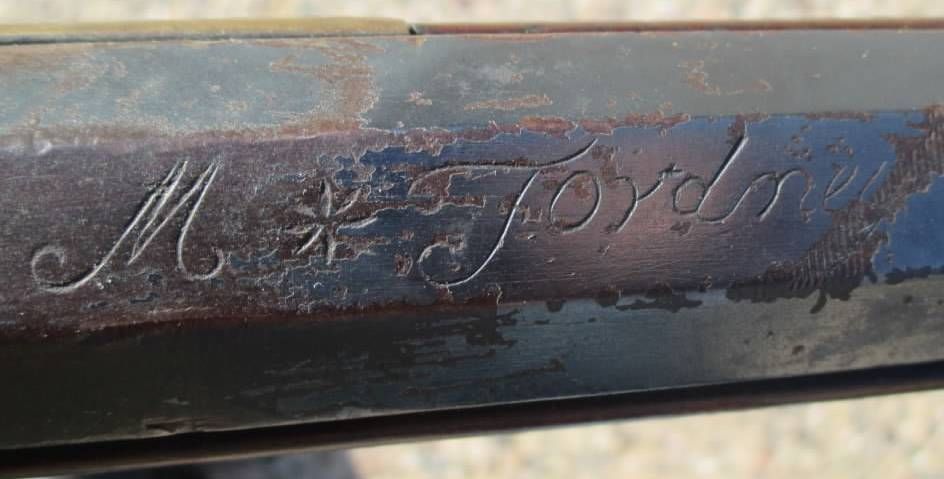
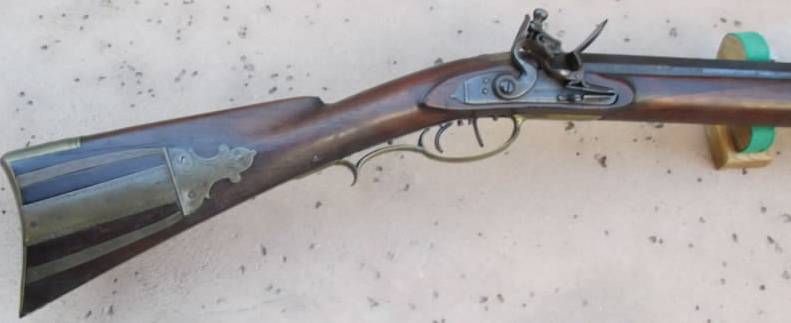

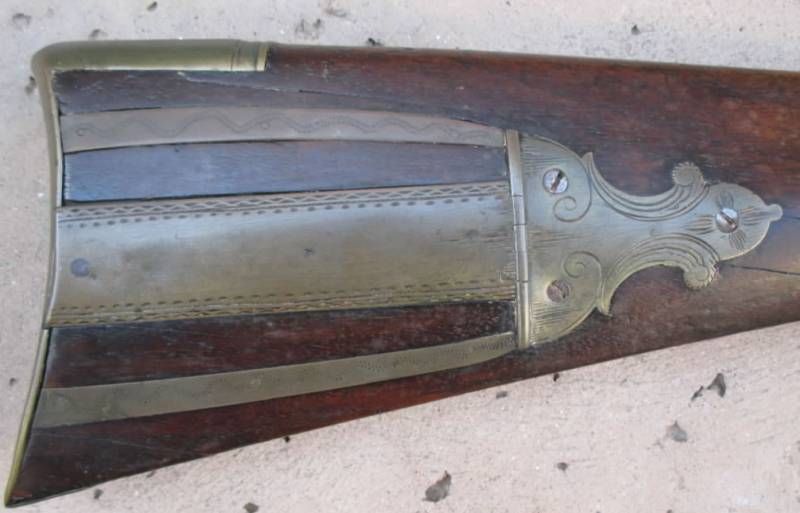
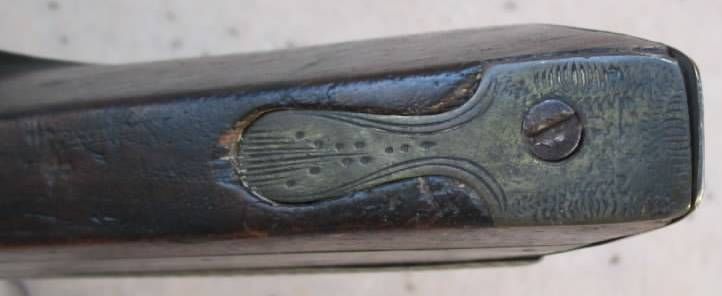

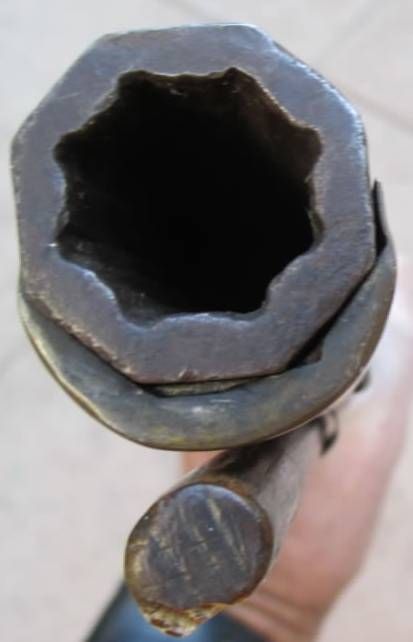


Comments:
Here is a real jewel that tells a story. The giant rifled bore, the sturdy walnut stock, flintlock mechanism, and the relative shortness of the gun all strongly suggest that this is a Rocky Mountain Rifle probably built in the 1820s-30s, if not earlier, to be carried west. That it was built by Melchoir Fordney of Lancaster is remarkable and could prompt a hundred questions about Fordney, his activities, and this rifle. It is a truly unique gun that has survived difficult times when most all seem to have been used up. Rocky Mountain rifles are seldom seen and almost always in bad shape if any are found. Some actual measurements would help to answer questions perhaps, but the gun very much speaks for itself. The owner might wish to take it apart and examine it all closely to see it any names are present elsewhere than the lock and top flat. Our thanks to the owner for placing it in the ALR Virtual Library.
------------------------------------------------------------------------------------
This is one of those rifles that I wish we had a couple more photos on, particularly the rear ramrod pipe area and the rear side facing. Since it is somewhat unique for a Fordney with its shorter-than-expected barrel, it makes me look at it more closely than a more "standard" Fordney. The forestock distance between front end of the side facings and rear ramrod pipe is shorter than any I've seen on a Fordney...yet if it really was made with a short barrel/stock, perhaps this is proportioned properly. The side facings do not look like Fordney side facings to me...too much wood left around the lock plate at the rear, and above the lock's "nose" in front. I would guess, but cannot tell with any certainty, the lock is a later replacement and the side facings have been "slabbed" over to reset the lock to clean up an old, sloppy mortise and put in an "appropriate" Lancaster lock...thus the very clean, almost too new, inner side facing edges adjacent to the lock plate's edges...not a big deal on old rifles, but if the side facings have been restored by "slabbing," then we've lost a little bit of the original gun's appearance...and other areas of the gun may have been restored as well. The gun also lacks Fordney's normal narrow line of chip carving that runs along the vertical edge of the butt plate on the back side of the butt. Again, on a simple, unadorned rifle this might be OK, but it's usually present so the lack of it is a change for Fordney. And I wonder why, like the missing chip carving along the butt plate edge on the back side, why Fordney didn't touch any area of the stock wood with at least some little carved decoration, somewhere, like he was so prone to do.
When I see a rifle by a well-known maker where a good number of his guns are known, and a new gun appears with a few details that differ from the norm, I tend to question the new piece, at least until I understand it better. This rifle may well be an early Fordney rifle based on the minimal butt curvature and lock plate with tail, perhaps a little early for the far-west trade, but intentionally made shorter than normal. I'd sure love to see better pictures of: 1) the rear pipe area showing the shaping of the wood and style of pipe, 2) the rear side facing and side plate, and 3) last/front pipe and nose cap area. Hard for me to form a final opinion on this rifle. When they raise a couple of questions, we could probably use a couple more "specific" photos to quite down the overly picky skeptics like me.
-----------------------------------------------------------------------------------
I should probably have said earlier that I viewed this piece personally at the Winter Las Vegas Antique Gun and Knife Show and found little to contest about the gun. It has a wood replacement repair on the left side by the side plate and that was about all I could see that indicated any repairs or changes. The stock is very old, sturdy, and the rifle is a hefty one. Caliber must be .70, or so. Those who are not familar with guns of the early west and fur trapping will likely not see what this piece really is. We are all used to the maple stocked, fancy PA rifle and cannot conceive that a main line maker would make a gun like this; a Rocky Mountain Rifle. Some other considerations:
Fordney used Dreppard locks made in Lancaster; Fordney was in Lancaster, so were many of the major makers of guns for the western trade. It is not out of the question that the gun was made on special order for a client who was heading west. Philip Creamer, for example, made such guns. Ohers did too. Many mainline makers made military muskets something that few seem to remember.
Finally, Mike D'Ambra was the seller of this rifle and I have few doubts that he has seen more rifles than all the members of this committee combined. He and I discussed this piece and it was his opinion that it is a good rifle. If you don't agree, speak to him yourself, at Baltmore.
-------------------------------------------------------------------------------------
For what itís worth, I saw this rifle both at Mikes home and the past Las Vegas show and have to say that in person, the rifle looks like a big Hawken style Fordney rifle. And to be honest, didnít see anything that would make me question its originality. It does have the wood repair that is mentioned and some wear and tear, but overall the rifle looks honest and original to me.
In hand, the rifle balances and shoulders well although it is heavy. And although not Fordneyís norm, I can imagine someone back in the day having him build such a gun to take out west.
Let me add, that in the pictures, I think I see what XXXX is seeing, but in person looks completely different.
------------------------------------------------------------------------------------
A fascinating rifle, by a famous maker, that we all knew made some rifles to "go West". Seeing a surviving example is not common. Guns like this were often "used up". I have no problem with it lacking some typical Fordney details. It was made for an entirely different purpose than most Fordney rifles that we have seen.

